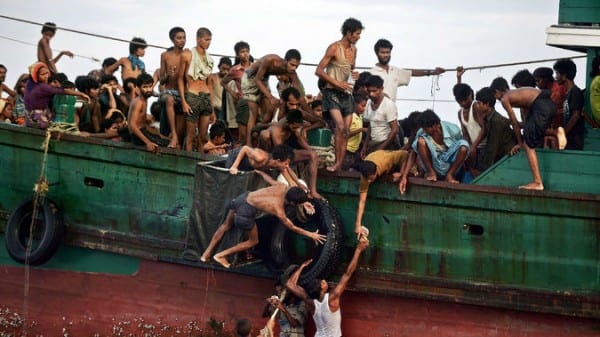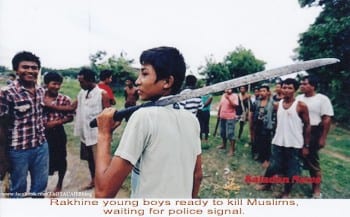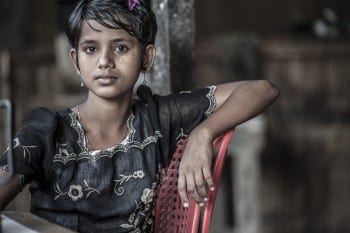Andrew Korybko (USA)

Fleeing Myanmar for obscure reasons, many Rohingya try to escape to Bangladesh. The “Boat People” refugees are becoming a global problem.
[dropcap]A[/dropcap]s complex as it may appear at times, the main consistency of US foreign policy is that it covers its pursuit of geopolitical self-interest with humanitarian and democratic rhetoric. There’s always an ulterior motive behind the US lecturing countries about ‘human rights’ and ‘democracy’, and those two key words should raise immediate red flags to any concerned decision makers in the targeted state that the US is addressing.
…
Being the expert image manipulator that it is, the US never shies away from exploiting human tragedy for its own strategic ends, a lesson that everyone would do well remembering when considering the Rohingya issue in Myanmar. While there certainly are some legitimate grievances that the Rohingya are leveling against the authorities, it’s evident that the US is already exploiting them for its own geopolitical ends. Washington wants to establish a military presence in the Bay of Bengal in order to control China’s pipelines through Myanmar (both of which go through Rohingya-inhabited Rakhine State), but in order to get to that point, it first needs for the Rohingya to have their own autonomous or independent government there.
The first part begins by unravelling the layers of complex context related to the issue, before going into the specifics of the current migrant crisis. Part II then explains how the US aims to create an autonomous or independent Rohingyaland by capitalizing off of this tragedy, and concludes with an examination of the multifaceted benefits it would receive through the creation of the South Asian “Kosovo”.
Unscrambling The Context
The plight of the Rohingyas and their place in the bigger picture of American geostrategy against China can appear to be an overwhelmingly complex topic, but it can be subdivided into three simpler categories of general understanding; American grand strategy; Myanmar’s domestic affairs; and the Rihingyas’ situation. By breaking down the bigger, thematic picture into smaller, finer details, one should be able to acquire a more solid understanding of how the US is relentlessly pursuing its own self-interest at the Rohingyas’ expense.
American Grand Strategy:
The US’ post-Cold War foreign policy has hinged on adhering to Brzezinski’s ‘Eurasian Balkans’ concept, which essentially stipulates that the US could manipulate preexisting ethnic, religious, and territorial issues in Eurasia in order to prolong its control of the supercontinent. This can be done in two ways: the method of indirect disorder has the US utilizing proxy actors to stir endless chaos, much as it’s currently doing with ISIL in the Mideast; while direct control involves the US conventionally asserting its on-the-ground dominance, just like it did by building Camp Bondsteel (one of its largest European bases) in occupied Kosovo after the 1999 War on Yugoslavia. Indirect disorder can be used as a modus operandi for establishing direct control, and this is precisely the game that’s at play with Rohingyaland along the Bay of Bengal.
Myanmar:
No place in South or Southeast Asia is more susceptible to the Eurasian Balkans concept of American-directed strategic state fragmentation than Myanmar, which has been fighting the world’s longest-running civil war since 1948. To unduly simplify the conflict, it involves the majority Burmese ethnic group in the central part of the country fighting against the myriad minority groups along its periphery, with the rebels seeking a federation but the government fighting for the status quo unitary nature of the state. While the war has been at a stalemate for quite some time, the opening of a new rebel front in the Rohingya’s Rakhine State could be the strategic shift that’s needed to turn the tide against the government, as none of the other rebelling regions or ethnicities is located along the coast.
This factor is exceptionally important since it could enable a slew of foreign patrons to ship massive amounts of material support to the rebels, perhaps even using plausibly deniable methods such as flying other nations’ flags above their arms-running vessels. The inland rebels have no such tactical advantage in this regard, which may be part of the reason why they have yet to be successful in their half-century-long campaign. The addition of a pro-federation rebel movement capable of receiving such supplies could make the decisive difference in finally tipping the balance of power against the government’s forces.

Rohingya refugees picked up in Thailand.
Rohingyas:
The demographic subject of the present article is at odds with the Myanmar government over its identity. The 800,000–1-million-plus Rohingyas claim that they constitute a unique ethnic group, but Naypyidaw sees them as nothing more than the descendants of illegal Bengali migrants, some of whom even fought against the state on several occasions. As such, the government refuses to confer them with citizenship, thus leaving them stateless and unwittingly complicating the present migrant predicament (to be described in the next section). Worse still, because they’re not considered to be citizens, the state is reluctant to actively protect them from the sectarian purges carried out by the ‘Buddhist Bin Laden’ and his pro-Western hyper-nationalist thugs. Instead, it’s settled on a policy of segregation, preferring to force them into separate communities ostensibly out of concern for their own safety. Many Rohingya protest these living conditions that some claim are contrary to their human rights, hence why so many of them have decided to flee the country. Sensing a convenient opportunity for geopolitical benefit, the US has taken up the torch of Rohingya guardianship, advocating loudly in their favor and becoming their de-facto international patron.
The Current Crisis
[dropcap]T[/dropcap]he Rohingya had already been on the Western media radar since their 2012 persecution, but it’s the current migrant boat crisis that’s made their cause seemingly more urgent. While there are no clear-cut numbers available, the UN estimates that around 100,000 of them have fled by sea in the past three years, which would represent between 10-12% of their total population in Myanmar. These discomfiting numbers clearly indicate that there are some serious domestic issues in Myanmar motivating their exodus, but in and of themselves they’re not cause for direct humanitarian concern. The problem arose when it was reported in early May that around 6000 Rohingya were thought to be lost in the Andaman Sea after having been abandoned by their human traffickers, and genuine horror was experienced when 139 graves were later unearthed in Malaysia, believed to be of dead Rohingyas who perished before reaching their ultimate destination. The squalid camps alongside the Thai-Malaysian border that the illegal Rohingya migrants are regularly kept in have led many to believe that they’re either being abused or held captive by their traffickers. All of these dangers have combined to generate what the UN referred to early last month as a “looming humanitarian crisis”, and the deluge of fake images and internet memes related to the issue have contributed to a feeling of global urgency in addressing it.
Regional Response:
The destination states of Thailand, Malaysia, and Indonesia don’t want to accept any more migrants, having already absorbed tens of thousands of them in the past couple of years, and previously refused to let the stranded boats land on their territory. According to officials, Malaysia already has received 120,000 Rohingyas, while Thailand claims to be housing 100,000 as it is. Nonetheless, because of the exorbitant international pressure directed against them, all three states countries have agreed to temporarily house the at-sea migrants until they can be sent back home or to a third country, thereby abandoning their earlier policy of turning back the boats. While this may temporarily de-escalate the crisis and give the floating migrants a safe reprieve from the dangerous high seas, it doesn’t address the root cause of why the Rohingya are risking their lives to leave Myanmar in the first place, which is something the US intends to resolve.

Some are ready to “solve” the Rohingya problem at sword point. Anti-muslim sentiment is high in some areas.
Official Myanmar And Bengali Positions:
The issue becomes even more complicated when one takes into account Myanmar’s official position on the matter. Naypyidaw asserts that human trafficking networks are to blame, not government persecution, and that many of the illegal migrants in question are actually from Bangladesh. Government representatives have accused some of them of pretending to be Rohingyas so as to receive preferential aid from the UN High Commissioner for Refugees that they wouldn’t be able to procure with their actual Bengali identity. While critics might hark that Myanmar is lying about Bangladesh’s connection to the migrant boat crisis, the latter’s Prime Minister Sheikh Hasina decreed that those leaving the country illegally would be punished because they’re “tainting the image of the country in the international arena and putting their life into danger”, on top of being “mentally sick” in their pursuit for money abroad. No matter how one feels about Hasina’s comments, the fact that she addressed the topic in such a way confirms that the Bengali government acknowledges that their citizens are involved in this crisis and that it’s not completely about Rohingyas. Her statement lends credence to Myanmar’s claims that many of the migrants may actually be Bengali and inconveniently dismantles the Western media myth that anti-Rohingya persecution is to blame for the boat crisis.
[box] Andrew Korybko is a political analyst and journalist with Sputnik who currently lives and studies in Moscow, He publishes primarily on ORIENTAL REVIEW. [/box]
[printfriendly]
Remember: All captions and pullquotes are furnished by the editors, NOT the author(s).




